Mastersound Compact 845 The Ear Review

Mastersound Compact 845
Tuesday, March 15, 2022
integrated valve amplifier
Richard Barclay
Cesare Sanavio founded Mastersound in 1994 with his two sons, Lorenzo and Luciano, channelling five decades’ experience building output transformers for other companies into the design of his own tube amplifiers. With Luciano Sanavio now at the helm, their portfolio has expanded and comprises three preamps, three power amps and no fewer than nine integrated amps. Among these are models that honour Cesare’s original designs such as the 300B SE and others that are the brainchild of Luciano including the Compact 845, a powerful single-ended triode that’s the focus of this review.
The Italian company continues to operate very much as a family business from its Arcugnano premises in Vicenza with a small but highly-skilled workforce. When you purchase a Mastersound amp it’s likely to have been worked on by no more than three people. As much as possible is manufactured in-house, including the vital output transformers that convert the high voltage from the output tubes into current to drive the loudspeakers. It is claimed that these hand-wound transformers constitute much of the ‘secret sauce’ that sets Mastersound apart from its competitors.
As its name suggests, the Compact 845 is based around the mighty 845 triode, one of the largest and most powerful vacuum tubes suitable for audio use. Arguably Mastersound’s purest 845-based integrated stereo amplifier, it uses only one preamp (ECC802), one driver (6SN7) and one power (845) tube per channel. The unit I received shipped with current production Psvane HiFi Series 845B tubes, an entry-level 845 that’s well regarded. For those eager to upgrade to something more special, the Chinese valve manufacturer has pricier offerings if you don’t fancy diving down the NOS rabbit hole.

My struggles in carrying this 34kg beast up the two flights of stairs to the listening room are evidence that the ‘Compact’ prefix is not to be taken literally. The bulk of the weight is to be found in the three huge transformer cylinders to the rear; these also apparently double-up as heatsinks, which is useful as there is no shortage of heat to dissipate in a Class A amplifier. The warmth emitted by the two towering 845s alone is enough to nudge the mercury northwards as the listening progresses. The valves for the left and right channels are mirror-imaged and guarded by a removable plate that encircles the ECC802s and 6SN7s and ascends over the 845s, protecting them without obscuring the amp’s functional beauty and flawless finish.
An uncluttered front panel provides a rotary input selector on the left and motorised volume dial on the right, the on/off switch is cleverly concealed underneath the left corner. On power up a small red LED blinks for thirty seconds as the valves pre-heat before turning constant when the amp is ready to use. Although the manual advises that peak performance is reached after a thirty minute warm up, listening from a ‘cold start’, as it were, is in no way a hardship. The supplied remote is a basic affair equipped only with buttons to adjust the volume. Carved from the same solid walnut that luxuriously bookends the amp’s chassis, it is chunkily-proportioned with radiused edges and sits very comfortably in the hand. Like many motorised volume controls, the turning speed is rather brisk so fine level adjustments call for only the briefest of presses. The handset works on RF instead of the usual IR and does not require a clear line of sight to the amp, the operating range is long enough to control the volume from another room.
The rear panel reveals a total of four source inputs (three line-level and one balanced) plus a Direct input. The Direct input bypasses the preamp circuit and volume control, useful if you want to connect an external stereo preamp or use the Compact as the power amp for the front left and right channels in a home cinema system. Being a single-ended amplifier the ‘balanced’ inputs are summed internally to single-ended, this reduces the input voltage by half and avoids large disparities in level when switching between RCA and XLR sources. A choice of eight and four Ohm loudspeaker taps are provided, these connect to different windings on the output transformers to ensure the most efficient delivery of power into the connected load. Finally, above the power inlet are two bias adjustment screws for servicing purposes, the Compact 845 has what’s described as semi-automatic bias.
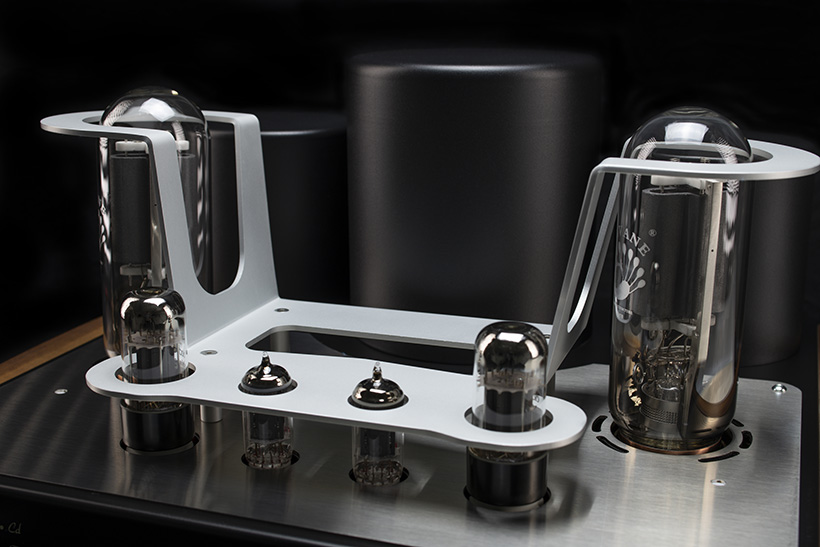
Many consider single-ended triodes (SETs) the holy grail of tube amps because they are the simplest of all designs with the fewest number of components in the signal path to degrade fidelity. Also, as the tubes operate in Class A mode, they amplify both the positive and negative parts of the input signal, avoiding the potential crossover distortion that results from ‘stitching’ these parts back together. What’s more, most SETs eschew negative feedback, this is often cited as a reason for their superior musicality and directness as many believe feedback harms dynamics.
These perceived advantages come with compromises, the most obvious being limited output power. The vast majority of SETs produce between just 2 and 8 watts per channel, which is why they are usually reserved for high-efficiency speakers. The Compact 845, however, delivers a prodigious 30 watts per channel, placing it among the most powerful integrated SETs in current production. In systems where an 8W SET might require partnering with 96dB or higher sensitivity speakers for realistic dynamics, the Compact 845 achieves the same maximum sound pressure level with a speaker that’s 90dB sensitive, which is far closer to the average sensitivity of modern loudspeakers and empowers listeners with more choice.
The absence of negative feedback means SETs produce more second order harmonic distortion than their push-pull counterparts, especially when the tubes are driven to their limits. While this type of distortion is much preferable to third order harmonics and is partly responsible for a pleasing tonality, too much of it can be undesirable. When the tubes are driven within their sweet spot, the level of second order distortion produced is much lower. With its high maximum power output, the Compact 845 has a much wider sweet spot in which distortion remains low and should therefore sound more transparent and effortless than a lower-powered triode.
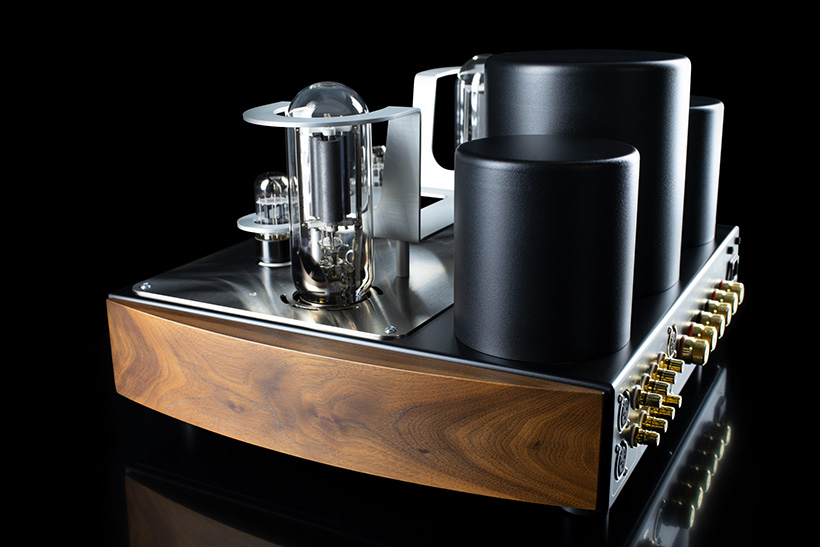
Eschewing negative feedback poses additional challenges that are more difficult to overcome, including roll-off at the frequency extremes and an increased output impedance. The extent of the roll-off is affected by the quality of the output transformers and, building upon Cesare’s original research and fifty years’ expertise, Luciano Savanio claims to have minimised this by developing a new construction technique that affirms Mastersound’s proprietary hand-wound transformers as the best in the business for power, dynamics and bandwidth. High output impedance reduces damping and increases the amplifier’s sensitivity to a loudspeaker’s impedance characteristics, potentially resulting in looser bass control and frequency response colourations*. As there is no easy way to further reduce output impedance without resorting to negative feedback, listeners have the choice of either: a) minimising its effect by choosing speakers with a flattish impedance curve; or b) embracing the tonal colourations that result from using speakers with large impedance swings.
The latter could be seen as a welcome opportunity to explore loudspeaker pairings and discover synergies that may not be possible with low output impedance amplifiers. For a reviewer it is a little more problematic. Impressions may be influenced by the amp’s synergy with the loudspeakers used during the evaluation much more so than other amplifier designs, and this interplay could be very different from that experienced by end users if their loudspeaker’s impedance characteristics differ enough.
*As the amplifier’s output impedance increases, the frequency response of the loudspeaker begins to track its impedance curve because more power is delivered at frequencies where the speaker’s impedance rises and less power is delivered at frequencies where the impedance falls.
Sound quality
Impressions were mostly formed using my floorstanding Celestion Ditton 66 and the Blumenhofer Tempesta 20 hybrid-horns I reviewed in January, both are similar in sensitivity (around 90dB vs 92dB). Like many Blumenhofer models, the Tempesta’s impedance curve is designed to work well with high output impedance tube amps so it ought to be a perfect partner for the 845. I also briefly auditioned Tannoy Monitor Gold 15 (95dB) and Spendor S3/5R2 (82dB). None of these speakers are particularly difficult to drive but their impedance curves differ and it was interesting hearing the effect this had on their presentations. DACs of choice included my reference Schiit Yggdrasil plus a Bricasti Design M3 – the latter a slighter warmer and smoother counterpoint to the former – both receiving data streams from the USB output of a Mac Mini.
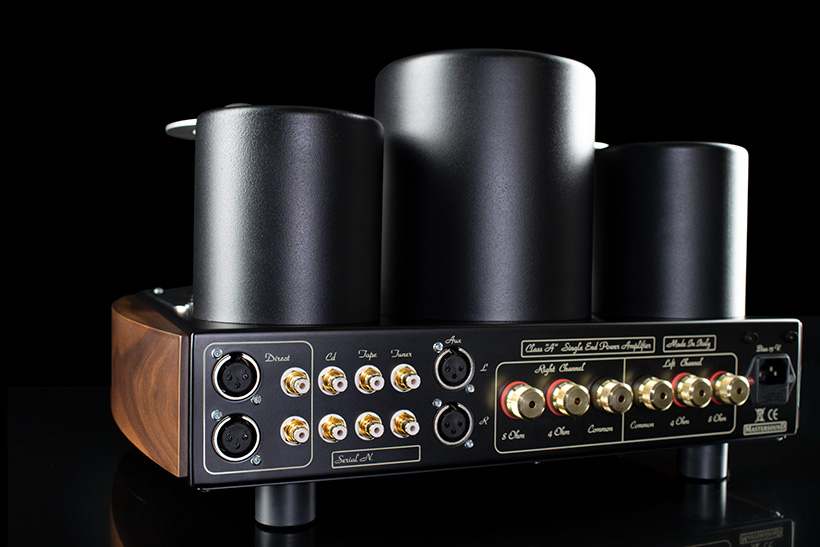
One of the first albums to be recorded digitally, Dire Straits’ Brothers In Arms (1985) exudes a slick sheen that can often be portrayed as sterile and soulless by playback gear with analytical proclivities. As Randy Brecker’s forlorn trumpet sets the wistful mood in Your Latest Trick, the Compact 845 gives us our first taste of SET magic. Brecker’s sensitive vibrato gains presence and there is more dynamic shading between his mellow and bright tones. The reverb tails from Omar Hakim’s ride cymbal skims and Mark Knopfler’s distant guitar cries waft in the air for longer, drawing the listener more deeply into the story that’s about to be told. After all these years I still marvel at this track’s ability to remove the wall behind my speakers and replace it with wide open space.
As the trumpet segues into the iconic tenor sax solo played by Michael Brecker (Randy’s brother), it’s evident that with the 845 you don’t just hear the instruments, you also feel the emotion of the musicians behind them. The sax has always been the star attraction with its smooth and sexy tone, but the Mastersound takes it to another level by fleshing out this instrument’s harmonic complexities more deliciously than any other amp I’ve auditioned. Knopfler’s voice also benefits from enrichment, his tone is thickened up a little and sounds more mature. The jazzy, bossa nova rhythm that drives the song is stronger than I remember, it now has some satisfying thump behind it and isn’t quite as diaphanous. There’s less emphasis on the leading edge and more on the sustain, the snare rim shots in particular have a fuller resonance and are no longer clipped. The groove is still tight and in the pocket but it has a more natural ebb and flow and, even though the musicians probably tracked their instruments separately, there is a stronger sense of connection between them.
Where there is genuine spaciousness in a mix the Compact 845 reproduces it accordingly, but this is an amp that prioritises cohesion over separation. It does not conjure additional space around instruments gratuitously, an audiophile trick that often gives the impression of performers placed several metres apart on a stage that’s too big for them. It is, however, very generous in its scaling. This especially benefits loudspeakers that are smaller than the instruments they are reproducing and helps them appear more life-size. Even though I prefer the tonal balance of the S3/5R2 with my reference solid-state Yamaha A-S3000 (100W, Class AB), this diminutive standmount fills my room more convincingly with the Mastersound. Big speakers, on the other hand, rarely need assistance to sound big, and while some may argue that the enlarged images presented by this SET aren’t entirely true to scale, they are immensely satisfying! Through 15 inch Tannoys the 845 delivers Leonard Cohen’s final album, You Want It Darker (2016), with a visceral palpability that’s not for the fainthearted. The grim imagery in the title track is intensified by the 845’s strong tonal saturation and huge presence, which makes Cohen’s frank acceptance of his impending demise even more profound.
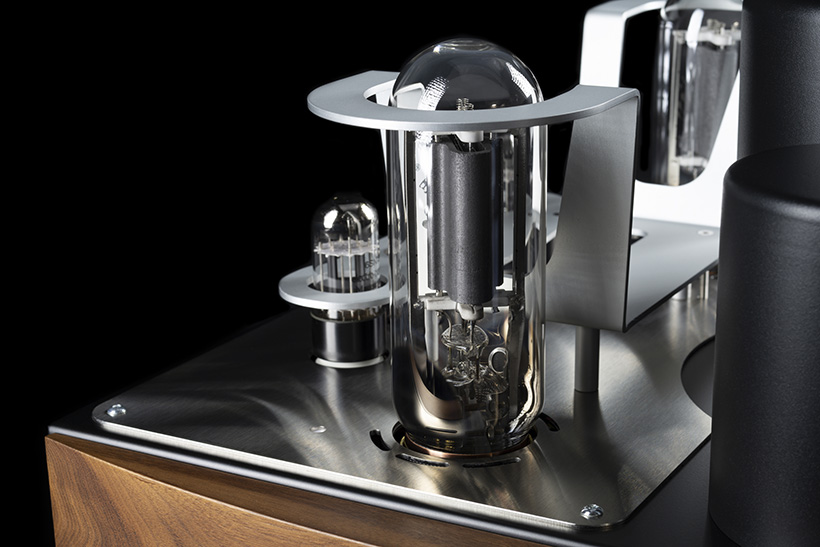
Though this amplifier may not exert a vice-like grip, it is surprisingly agile for an SET and does not lose its composure when faced with beat-driven music. From Telefon Tel Aviv’s IDM masterpiece Fahrenheit Fair Enough (2001) to Daft Punk’s infectious disco-inspired Random Access Memories (2013), it does an admirable job of punctuating rhythms firmly enough that the listener never loses sense of the groove. Even with the ported Blumenhofers, I am not subjected to excessive flabbiness or smear when I switch from the Yamaha to the Mastersound. Nor am I forced to sacrifice extension; the Celestions and Blumenhofers plumb the same depths with both amplifiers (note this wouldn’t be the case if the speakers’ impedances dropped at low frequencies). The 845’s bass may not be as sinewy or snappy but it is certainly not short of texture or oomph. To those who’ve shied away from SETs in the past due to concerns over an ill-defined or lethargic bottom end, this one should change your opinion.
Synergy
My Celestions were largely immune to the 845’s output impedance, exhibiting some roll-off only in the very highest frequencies. Contrary to expectation, this didn’t come at the expense of detail; there was a smidgen less air and sparkle than I’m used to, but instrument timbres were eerily lifelike and possibly the most natural I’ve heard from this speaker. Roll-off started earlier on the Tannoys but it balanced out their response nicely as older models with the classic ‘pepperpot-style’ compression horn tweeter tend to draw attention to themselves, especially when listened to on-axis. The Mastersound and Blumenhofers proved an inspired pairing. Dimming the level of the compression horn tweeter slightly whilst increasing the weight of the lowest octaves, the 845 encouraged a warmer chiaroscuro (balance between light and shade) and made this incisive hybrid-horn design more tolerant of poorer recordings without blunting its thrilling dynamic attack. The Spendors were taken in the opposite direction; they became brighter in the upper mids and lower treble and had more bite with this SET than with my 100W Yamaha, which, by comparison, was more finessed and laid-back. Though dynamic headroom was limited because of the Spendors’ much lower sensitivity, in smaller listening spaces or nearfield setups the 30W Compact 845 still pushed this mini monitor surprisingly close its limits without compressing too much.
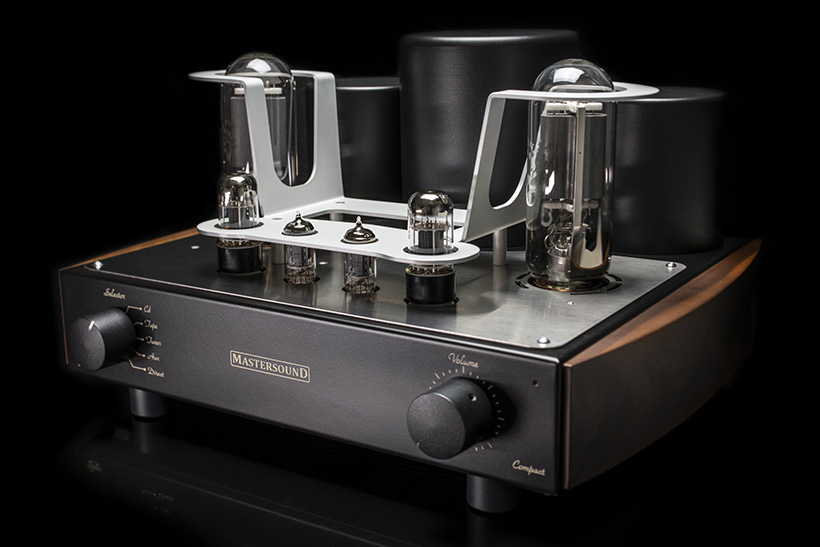
During my audition I swapped out my reference loudspeaker cables and interconnects for high-end offerings from Japanese cable manufacturer, Tiglon, as I was keen to explore the amplifier’s performance ceiling. I started at the back end of the system with MSS-DF100SP-HSE speaker leads before installing TPL-2000 RCA and XLR interconnects and finally replacing Mastersound’s stock power cord with a TPL-2000A. All of these cables use dip-formed oxygen-free copper for the purest conductivity and feature Tiglon’s patented Magnesium Shield Technology for superior noise rejection and vibration suppression. Each swap brought subtle improvements in instrument separation, low-level detail retrieval and overall fluidity and confirmed that the 845 readily reveals weak links in the chain. It’s very much worth investing in quality cabling for this amp to wring out those last few percentage points of performance.
Verdict
The powerful Mastersound Compact 845 removes the requisite for high-efficiency speakers and bucks the ‘pipe and slippers’ SET stereotype by balancing seductive, tubey lushness with ballsy, dynamic punch. Benign loads are required only if you want an uncoloured frequency response, much of the pleasure from this amp comes from matching it with speakers to achieve synergies that simply aren’t possible with other tube topologies. The Compact 845’s gorgeously rounded tone and dramatic scale presents the energy and emotion in musical performances with a sincerity that’s soul-stirring.
SPECIFICATIONS:
Type: single ended triode integrated amplifier
Analogue inputs: 3x RCA, XLR
Direct inputs: RCA, XLR
Phono input: N/A
Digital inputs: N/A
Analogue outputs: none
Bluetooth: N/A
Headphone output: N/A
Speaker outputs: 4 Ohm, 8 Ohm 5-way binding posts
Power Output: 30W into 8 ohms; 30W into 4 ohms
Dimensions (HxWxD): 275 x 415 x 460mm
Weight: 34kg
Warranty: 5 years (valves 1 year)
PRICE:
£7,995
0 Comments